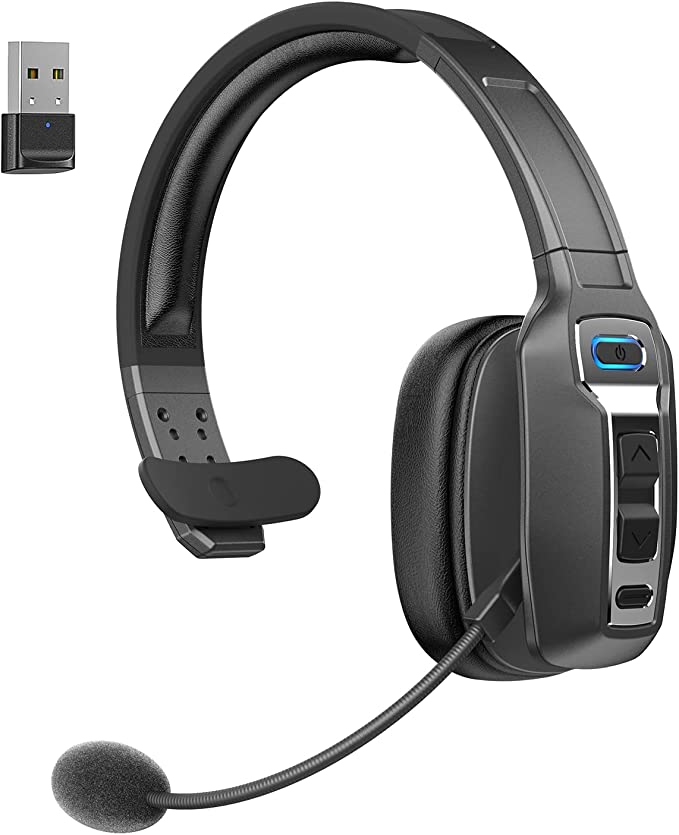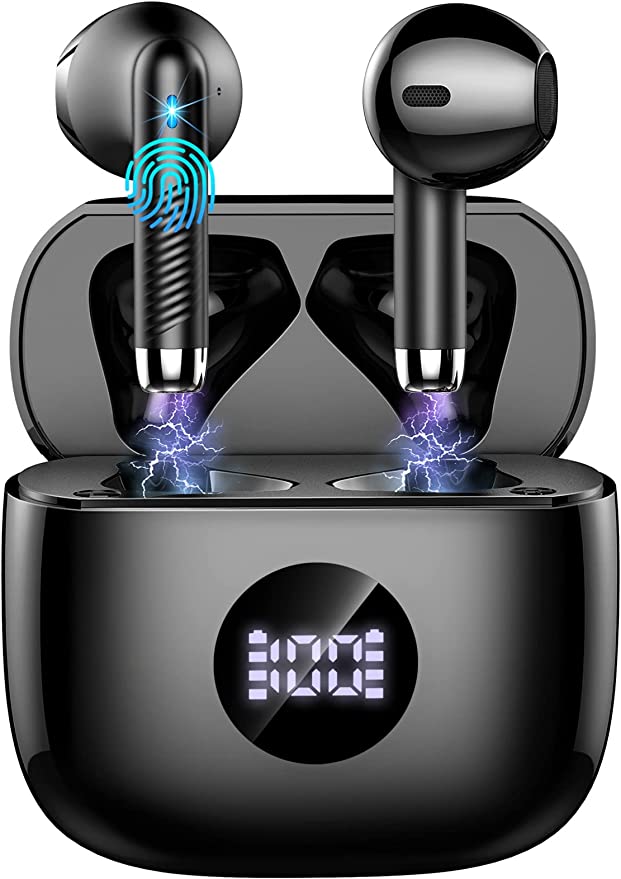In our hyper-connected world, the ability to communicate clearly is often taken for granted – until it fails us. Picture this: you’re a trucker coordinating logistics over the constant drone of the engine, a remote worker trying to sound professional amidst household chaos, or a warehouse operative relaying critical information over clanging machinery. In these moments, standard earbuds or phone speakers fall short. The ambient noise floor rises, swallowing voices and breeding frustration. This is where specialized communication tools, like wireless headsets, step in. But what truly separates a functional headset from one that excels? It often lies beneath the surface, in the thoughtful application of audio engineering, wireless communication principles, and ergonomic design. Let’s take an engineer’s look at the Dytole DY101 Trucker Wireless Headset, using its description as a launchpad to explore the science that aims to deliver clear, reliable, and comfortable communication.
The Intelligent Sound Filter: How the DY101 Battles Background Noise
The headline feature touted for the DY101 is its “AI-Powered Noise Canceling,” claiming to eliminate a remarkable “99% of disturbances like traffic noise, wind noise, piercing noises, and background music.” This sounds impressive, but what’s happening technologically? The description points towards “environmental noise canceling technology” (ENC) utilizing an “intelligent AI algorithm.”
To understand this, let’s first think about sound itself. Sound travels as waves, characterized by frequency (pitch) and amplitude (loudness). Your voice has a specific range of frequencies and dynamic patterns. Background noise, whether it’s the low rumble of an engine, the sharp clang of metal, or the variable frequencies of wind, has different acoustic characteristics. The headset’s microphone, acting like its ear, initially captures all these sounds – the voice you want to transmit and the noise you don’t.
This is where the “intelligent AI algorithm,” a piece of sophisticated software running on a Digital Signal Processor (DSP) chip within the headset, comes into play. Based on the product description focusing on microphone performance and eliminating external noise for the listener on the other end, this technology is likely a form of advanced ENC. Unlike Active Noise Cancellation (ANC) which generates anti-noise to cancel out sound reaching the wearer’s ear, ENC typically focuses on cleaning up the signal captured by the microphone before it’s transmitted.
Think of this AI algorithm as a highly trained sound engineer or an exceptionally discerning bouncer at a club. It analyzes the incoming audio stream in real-time, constantly looking for the unique ‘fingerprint’ of human speech amidst the cacophony. It learns to distinguish the patterns and frequency ranges typical of your voice from the characteristics of common background noises. Once identified, the algorithm works to significantly reduce the amplitude of (or ‘filter out’) the unwanted noise signals while preserving and even enhancing the voice signal. The claimed “99% elimination” figure represents the manufacturer’s assertion of this filtering effectiveness against specific types of noise. The ultimate goal? To ensure that the person you’re speaking to hears your voice with clarity and authenticity, free from the distractions of your immediate environment. This is crucial for professionalism and reducing listener fatigue during important calls.
The Invisible Dance: Mastering Wireless Connections and Distance
Freedom from wires is a major draw for modern headsets. The DY101 employs Bluetooth 5.2 to achieve this wireless link. Bluetooth technology itself is a fascinating piece of radio engineering operating in the busy 2.4 GHz Industrial, Scientific, and Medical (ISM) band – the same neighborhood used by Wi-Fi, microwaves, and other devices. To coexist and maintain a stable connection, Bluetooth uses a technique called Frequency Hopping Spread Spectrum (FHSS). Imagine the headset and the connected device (like your phone or computer) constantly performing a rapid, synchronized dance, hopping between dozens of narrow radio channels hundreds of times per second according to a pseudo-random sequence. This agility makes the connection resilient to interference; if one channel is noisy or occupied, the system swiftly moves to a clearer one.
While the description doesn’t detail the specific enhancements of Bluetooth 5.2 over previous versions, newer Bluetooth standards generally aim for improvements in data transfer speed, connection stability, and power efficiency – all beneficial for a communication headset.
A particularly practical feature highlighted is the ability to “seamlessly connect two devices simultaneously.” This doesn’t mean audio streams from both play at once. Rather, it implies the headset maintains active pairings with two source devices (e.g., a laptop for video calls and a smartphone for phone calls). According to the description, a single click of the MFB (Multi-Function Button) allows you to swiftly switch your active audio source. This relies on Bluetooth profiles that manage multiple connections, allowing you, for instance, to pause music or a meeting on your PC to answer an incoming call on your phone without manually disconnecting and reconnecting.
Wireless range is another critical parameter, governed by the physics of radio wave propagation. The DY101 description claims a typical range of up to 49 feet (15 meters) and an extended, unobstructed range of up to 164 feet (50 meters), particularly noted for truckers. Why the difference? Radio signals, like light, weaken over distance (following roughly an inverse square law). Furthermore, they are absorbed or reflected by physical obstacles. Walls (especially concrete or metal), furniture, and even the human body can significantly attenuate the 2.4 GHz signal. The 164-foot figure likely represents an ideal scenario – a clear line of sight between the headset and the connected device, perhaps useful if a trucker needs to step briefly away from their cab while remaining on a call. The 49-foot range is a more realistic expectation for typical indoor environments with potential obstructions. This wireless capability grants valuable freedom, whether it’s pacing during a call or moving around a workspace without being physically tethered.
More Than Just a Battery: The Science of Staying Powered
A headset running out of power mid-conversation or mid-shift is more than an inconvenience; it’s a productivity killer. The DY101 description boasts an impressive “up to 65 hours of working time” from a single 2-hour charge, utilizing a modern USB-C port. What allows for such endurance?
The key lies in the synergy between energy storage and energy consumption. Modern wireless headsets predominantly use Lithium-Ion (Li-Ion) or Lithium-Polymer (Li-Po) batteries. These battery chemistries are favored for their high energy density – meaning they can store a relatively large amount of energy in a small and lightweight package. Think of it like having a very efficient fuel tank. A 65-hour working time suggests a combination of a reasonably sized battery cell and, crucially, efficient power management within the headset.
Every component draws power: the Bluetooth radio transmitting and receiving signals, the DSP chip performing noise cancellation calculations, and the speaker driver converting electrical signals back into audible sound. Achieving long battery life requires careful engineering to minimize the power draw of each component during operation and potentially implementing smart power-saving modes when idle. Bluetooth 5.2 itself often includes features designed for lower energy consumption compared to older standards. The 2-hour charge time via USB-C points to modern charging circuitry capable of delivering power efficiently and safely to the battery. Features like a remaining battery indicator and low-battery voice reminders (when connected to a phone, as per the description) are practical additions that help users manage this power resource effectively, ensuring the headset is ready for those long hauls or extended work sessions.
Beyond Sound: Designing for Human Factors
For a device intended to be worn for potentially hours on end, acoustics and electronics are only part of the story. Ergonomics – the science of designing equipment to fit the human body and its cognitive abilities – plays a vital role in user acceptance and sustained productivity. The DY101’s design choices reflect several ergonomic considerations.
Its “Over Ear” form factor means the earcup completely encloses the ear. Compared to on-ear designs which press directly onto the ear cartilage, over-ear designs generally aim to distribute the clamping force over a wider area of the head around the ear. This can significantly reduce pressure points and discomfort during long wearing periods.
The materials used are critical. The description mentions “ultra-soft protein leather earcups featuring memory foam padding.” Protein leather is a type of synthetic leather designed to mimic the softness and feel of real leather, often with good durability. Memory foam is known for its viscoelastic properties – it conforms slowly to the shape pressed against it (in this case, the side of the head around the ear) and returns slowly to its original shape when pressure is removed. This conformability helps distribute pressure evenly and can create a better acoustic seal around the ear. A good seal not only enhances perceived audio quality by blocking some external noise passively (known as noise isolation) but is also essential for comfort.
Adjustability is key because human heads and ears vary significantly in size and shape. The ability to wear the headset on either ear caters to user preference. The “270-degree rotatable and curved microphone” allows the user to position the mic optimally close to their mouth for clear voice pickup, regardless of which ear they choose or their specific facial structure. While comfort is subjective, these design elements – form factor, materials, adjustability – represent engineering choices aimed at minimizing physical strain and fatigue, allowing users like truckers or call center agents to stay focused on their tasks rather than being distracted by an uncomfortable headset.
Little Things That Make a Difference
Beyond the core technologies, some practical features contribute to the overall usability. A dedicated “mute button” is essential for professional communication, allowing users to quickly silence their microphone during calls or meetings without fumbling with software controls. The inclusion of a “USB Dongle” is a thoughtful touch, providing an easy way to connect the headset to desktop PCs or older laptops that might lack built-in Bluetooth or have incompatible drivers. Lastly, it’s important to note the explicitly stated limitation: the DY101, according to the description, “does not work with desk phones landline and IP phones.” This clarifies its intended use with standard Bluetooth-enabled computing and mobile devices.
Synthesizing the Science for Seamless Communication
The Dytole DY101 Trucker Wireless Headset, as presented in its description, serves as an interesting example of how various technologies converge to address specific communication challenges. The quest for clear audio hinges on sophisticated microphone technology and digital signal processing, embodied in its claimed AI noise cancellation, designed to intelligently separate voice from background chaos. Wireless freedom and flexibility are delivered through Bluetooth 5.2, enabling untethered movement, stable connections, and multi-device management, with range capabilities tailored to different environments. Extended use is made possible by high-density battery technology coupled with efficient power management, aiming to banish battery anxiety. And critically, the potential for hours of continuous wear is supported by ergonomic design principles, focusing on pressure distribution, material comfort, and adjustability.
Ultimately, understanding the science and engineering principles behind features like noise cancellation, wireless protocols, battery chemistry, and ergonomic design allows us to appreciate such devices not just as gadgets, but as carefully considered tools. They represent ongoing efforts to harness technology to overcome environmental limitations and enhance our fundamental human need to connect and communicate clearly and effectively, whether across a noisy factory floor or the vast expanse of the open road.




